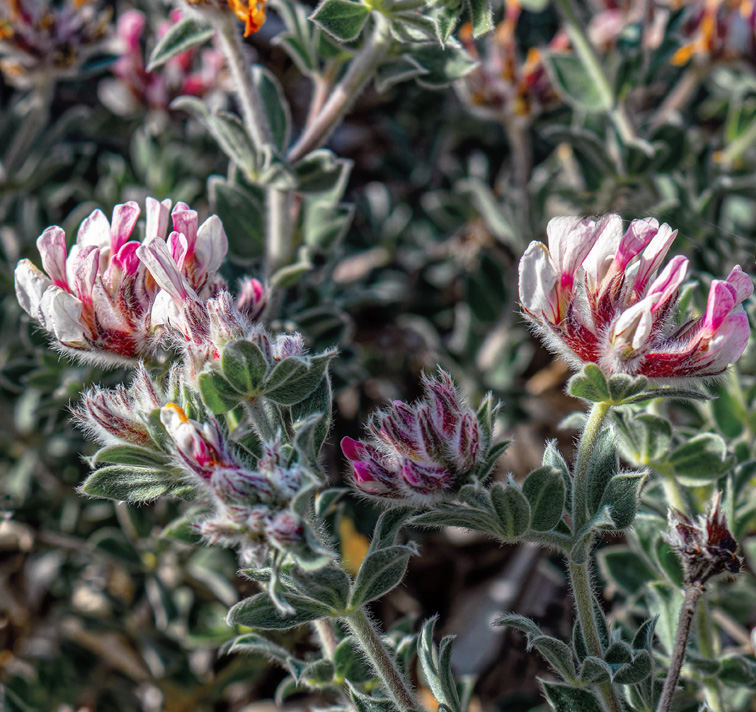- 1-9 pkts $4.50
- 10 pkts FREE
- Express post $12
Dorycnium hirsutum
HAIRY CANARY-LOTUS
Dorycnium hirsutum answers the prayers of gardeners troubled by heat and limited water.
Prayers answered for gardeners with heat and limited water
Hairy Canary Lotus is a groundcover from the hottest, rockiest parts of the Mediterranean – Portugal, Spain, Greece, Turkey and Northern Africa.
So of course it revels in heat and dry conditions.
Mass of white lotus blooms touched with pink & blue
Dorycnium hirsutum is in bloom for months.
With lotus shaped little heads, white flushed with pink and blue.
That are particularly lovely against the pale silky foliage.
Soft woolly silver-grey foliage is a perfect foil
The silky foliage of Dorycnium hirsutum makes a densely clothed groundcover of silvery-grey woolly little leaves.
Making the perfect colour and soft texture foil to its own dainty flowers, plus any other nearby flowers – of any colour.
This is a quietly stylish plant. (Hirsutum means hairy).
Velvety cover for hot & dry spots
This tough little shrub-let, with its silver velvet coat on, is perfectly adapted to resist heat and dry.
Long blooming from spring, through summer, into autumn
The little lotus-shaped flowers of Dorycnium hirsutum may be dainty and petite, but what they lack in size they make up for with abundant quantity and long blooming.
Blooming continuously from mid-spring, on through the hottest months of summer, and into autumn.
Adding to the fine, dainty, shimmering silver look of this lovely plant.
Drought resistant groundcover
Dorycnium hirsutum is toughly drought resistant once established, and like a camel can go for quite a while between drinks.
Carpets, spills & cascades
This evergreen shrub-let is low and wide, and looks lovely carpeting under taller shrubs in hot places; spilling over a rock wall or out of a container; or cascading down a slope that needs clothing.
It can be mingled with Australian natives and not look out of place.
Beloved by bees pollinators & honeyeater birds
Small honeyeater birds are a delight to watch as the dart from flower to flower over all the warm months. But they have to move over for all the bees and other pollinators who also adore the long blooming flowers.
Unpalatable to rabbits & deer
Fortunately rabbits and deer are not amused by the taste of the foliage.
Naturally adapted to rocky, sandy hot places
Dorycnium hirsutum is naturally at home in sites are rocky, or have gravel and sandy soils.
It is not a hungry plant, so stays compact and longer blooming on a leaner diet.
So do not overfertilize, and especially do not overwater or plant in a moist spot.
Instead it loves perfect drainage; a terracotta pot; a very well drained slope; or growing amongst rocks.
And relishes exposure to sun and wind.
Low maintenance, pest & disease resistant
The only work is an optional shear back once a year, just to keep it as dense as you wish / or you can let it relax and be natural – it will not care either way.
Dorycnium hirsutum is also rarely if ever troubled by pests and diseases (as long as it is not overwatered).
It is also winter frost hardy and can cope with temperatures down to approx. 12C.
Evergreen low, wide, ground-covering shrub.
30-45cm High approx. x 80cm – 1m. Wide.
SEED SOWING ADVICE: QUICK & EASY
Suits beginners & gardening with kids
Dorycnium hirsutum seeds are very quick and easy to germinate.
They can be sown indoors year round, whenever suitable temperatures can be provided.
OR
They can be scattered directly in the garden where they are to grow.
Best sown outdoors in late winter to spring.
Sow indoors for rapid & maximum germination: First abrade the hard surface of these seeds – by rubbing the seeds with fine sand between your hands, or rubbing gently between two sheets of fine sandpaper (seed scarification).
This allows moisture to penetrate the hard seed coating more quickly and promotes quicker germination.
Soak overnight
Now boil some water, and allow to come just off the boil, then pour over the seeds.
Allow the seeds to soak overnight (approx. 12 hours).
Then sow the seeds on the surface good quality seed raising mix.
Then gently pat the seeds on the surface of the mix to ensure good contact.
Cover the seeds with seed mix to a depth of approx. 5mm. (Or about the same depth as their diameter).
Now soak the sown punnet in a shallow water bath, so the moisture percolates up from below through to the surface of the mix.
Cover the sown, moist punnet with black plastic or cardboard, as these seeds germinate best in the dark.
Remove the cover as soon as sprouts appear.
Then place in a warm, well lit place (not in any direct sunlight), or place on a heat mat.
Temperatures of 18-21 degrees C are best for rapid and optimum germination.
Continue to keep consistently moist by misting from a water-spray bottle.
And covering with a clear lid or plastic bag will also help to maintain consistent moisture.
Seeds germinate in 14 to 21 days approx.
Pot on seedlings to harden off and mature before finally planting out in the garden.
Seed Count: 8 seeds per pack approx.
(We always aim to exceed the seed count and give a generous serve)
Click here for Nursery Open Days & Open Gardens Information
https://www.gardivalia.com.au/open-gardens
Click here to go back to Seeds Shop
https://www.seedscape.net.au/shop/
Related products
-
Add to WishlistAlready In WishlistAdd to Wishlist
-
Add to WishlistAlready In WishlistAdd to Wishlist
-
Add to WishlistAlready In WishlistAdd to Wishlist
-
Add to WishlistAlready In WishlistAdd to Wishlist





